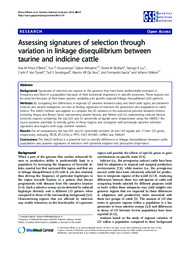Assessing signatures of selection through variation in linkage disequilibrium between taurine and indicine cattle.
Assessing signatures of selection through variation in linkage disequilibrium between taurine and indicine cattle.
Author(s): O'BRIEN, A. M. P.; UTSUNOMIYA, Y. T.; MÉSZÁROS, G.; BICKHART, D. M.; LIU, G. E.; TASSEL, C. P. V.; SONSTEGARD, T. S.; SILVA, M. V. G. B.; GARCIA, J. F.; SÖLKNER, J.
Summary: Signatures of selection are regions in the genome that have been preferentially increased in frequency and fixed in a population because of their functional importance in specific processes. These regions can be detected because of their lower genetic variability and specific regional linkage disequilibrium (LD) patterns. By comparing the differences in regional LD variation between dairy and beef cattle types, and between indicine and taurine subspecies, we aim at finding signatures of selection for production and adaptation in cattle breeds. The VarLD method was applied to compare the LD variation in the autosomal genome between breeds, including Angus and Brown Swiss, representing taurine breeds, and Nelore and Gir, representing indicine breeds. The conclusions are that VarLD method is a powerful tool to identify differences in linkage disequilibrium between cattle populations and putative signatures of selection with potential adaptive and productive importance.
Publication year: 2014
Types of publication: Journal article
Unit: Embrapa Dairy Cattle
Observation
Some of Embrapa's publications are published as ePub files. To read them, use or download one of the following free software options to your computer or mobile device. Android: Google Play Books; IOS: iBooks; Windows and Linux: Calibre.
Access other publications
Access the Agricultural Research Database (BDPA) to consult Embrapa's full library collection and records.
Visit Embrapa Bookstore to purchase books and other publications sold by Embrapa.

